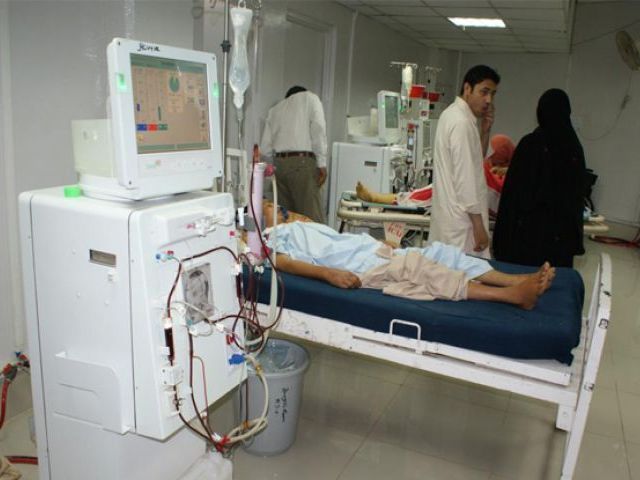
The terms of endearment in Pakistani languages include ‘liver’. If you speak English, you can call your beloved your ‘heart and soul’. If you are a Pakistani, you can also call them your ‘liver’. A mother can call her child ‘lakhte jigar’ (a part of the liver). A courageous man is said to have a ‘lot of liver’ (bara jigar wallah). A famous Urdu poet is called Jigar Muradabadi (The Liver of Muradabad).
Pakistani livers are currently under attack by viral hepatitis. There are many viruses which affect the liver. Some of them cause acute illness and subsequent recovery. There are others which can lead to chronic illness, cirrhosis of liver and its complications and liver cancer. Among these chronic viruses, Hepatitis B and C are endemic in Pakistan.
It has been shown through epidemiology studies that about five percent of the Pakistani population has Hepatitis C, although there are pockets of much higher prevalence in the big urban centres. Therefore, over 10 million people in Pakistan have Hepatitis C, second only to China as far as total number per nation is concerned. Thirty per cent of all hospital admissions are due to complications of viral hepatitis. These complications include, life threatening bleeding which is often fatal, swelling of the abdomen due to fluid, jaundice, drowsiness and coma, liver cancer and liver failure.
How did we come to be in such a sorry state? The likelihood is that this is due to unsafe medical practices. Pakistan tops the world in the average number of injections given per person in a year. The virus spreads through contamination of needles with blood. It is unfortunately common to reuse injection syringes in Pakistan both by qualified and non-qualified medical practitioners. Blood transfusions, not screened for viruses and razors, used by barbers are other suspected routes of transmission.
Fortunately, the treatment of Hepatitis C has progressed rapidly. The past few years have seen revolutionary new treatments come on line, so that in some countries, it is now feasible to eradicate the virus completely like the smallpox virus. We need to try our best to be among those countries. The first of these wonder drugs is called Sofosbuvir or Sovaldi. It was manufactured by Gilead, a multinational company based in the USA. I was fortunate to attend the Pakistan Society of Gastroenterology conference in Lahore in 2013. One of the working groups reviewed the Prime Minister’s Programme for Hepatitis C. The group included the famous American hepatologist, Dr Arun Sanyal who was instrumental in liaising with the CDC (Centre for Disease Control), a US Government agency for control of infections. The CDC was supportive of making the new medication available to low-income countries at an affordable price.
I recently met Usman, who runs the Ferozsons Laboratories and who has negotiated with Gilead over the past few years. Sofosbuvir was made available in Pakistan for a price which was 1 per cent of the market price in the USA. Usman told me that he found a real commitment in the company to help patients in the developing countries with a high burden of disease. The other countries which have benefited are India, Egypt, Nigeria and many more. The price is usually calibrated to the national income.
The market price of the drug in the US is $84,000 for a 12 week course of treatment, or nearly Rs3 million per month. When it was launched, there was a huge demand for new Hepatitis C drugs. Sovaldi, at a price of a thousand dollars a tablet, became the most profitable drug launch in history, grossing $10 billion in 2014. In Pakistan the cost per month has been Rs32,300.
The medication is used in combination with other drugs for a course of three to six months. In most countries, the drug is prescribed by a specialist. As in Pakistan, the number of specialists is quite low as compared to the needs of the population, any registered medical practitioner can prescribe the treatment. The medication is dispensed on a monthly basis and is available on a named patient basis, on the production of a national ID card.
I was pleasantly surprised to learn that the company has given licences to regional pharmaceutical companies (all of them in India), to manufacture the basic drug locally. They have also allowed other companies to manufacture the tablets and nine companies from Pakistan have registered. This would mean that the monthly cost of the drug will come down to five to six thousand rupees.
The good news does not end here. Another combination tablet called Harvoni by the same company has since become available. It is a combination of Sofosbuvir and Ledipasvir and is even more effective. This drug is also sold on the same basis at a highly discounted price. There are numerous other drugs which have been launched by other companies, and the likelihood is that competition will ensure cheaper drugs.
My school friend Ghias, who is a top physician and a master endoscopist in Lahore, has recently done an analysis of the first 300 patients he treated with Sofosbuvir. His results show that for the commonest group of patients treated with Sofosfubir, i.e. those with chronic active Hepatitis C of type 3, not previously treated, the cure rate was 100 percent. The cure rate in similar patients with advanced cirrhosis who have previously failed on treatment was 65 percent which is still a vast improvement.
I have seen Ghias’s unit at the Lahore General Hospital. I thought it was a pretty decent setup in a resource-limited environment. I was impressed with the Nursing Sister who has kept a good paper record of the patients treated. Recently, they have moved to computerised record keeping.
I attended the American Liver Meeting in San Francisco in November last year. The health minister of Georgia presented his country’s plan to control and eradicate Hepatitis C. A similar plan was presented by the Egyptian delegation. Interestingly, there were vocal protests outside the conference centre about the pricing of the Hepatitis C drugs.
These control and eradication programmes can only be successful if there is a functioning health infrastructure, robust gathering and analysis of data and adequate financial resources, but most importantly a motivated and well informed political leadership. The Prime Minister’s Programme for Hepatitis C was started in Pakistan in 2005. It was continued and strengthened by the next prime minister, Yusuf Raza Gilani. With the devolution of health affairs to the provinces, it is now being run in the Punjab by the Health Services Director.
I think we need a national viral hepatitis ‘czar’ or maybe four czars, one from each province, in turn, every year. We need to have a national plan including prevention measures, disease surveillance, laboratory support, audit and assessment. There is much desire in the international and expatriate community of professionals to help and support these efforts.
You can find information about liver diseases in English and Urdu at the following website developed by the author: www.jigarinfo.com
Published in The Express Tribune, April 17th, 2016.



























































COMMENTS
Comments are moderated and generally will be posted if they are on-topic and not abusive.
For more information, please see our Comments FAQ